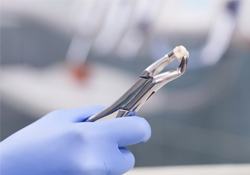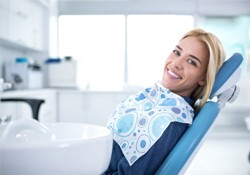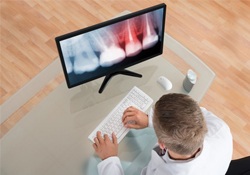Tooth Extractions – Harrisonburg, VA
Removing Teeth to Protect Your Oral Health
 Dentists do everything they can to help patients keep their natural teeth. Restorative dentistry has made this process much easier and more accessible to more people. However, when a tooth is damaged beyond repair, the best course of action is to remove that tooth before it can cause future harm to your neighboring teeth and gum tissue. With the help of the dentists and team members at Harrisonburg Family and Cosmetic Dentistry, you can rest assured your extraction will be as comfortable and straightforward as possible. If you’re experiencing issues with your tooth, don’t hesitate to contact our office and get scheduled for treatment!
Dentists do everything they can to help patients keep their natural teeth. Restorative dentistry has made this process much easier and more accessible to more people. However, when a tooth is damaged beyond repair, the best course of action is to remove that tooth before it can cause future harm to your neighboring teeth and gum tissue. With the help of the dentists and team members at Harrisonburg Family and Cosmetic Dentistry, you can rest assured your extraction will be as comfortable and straightforward as possible. If you’re experiencing issues with your tooth, don’t hesitate to contact our office and get scheduled for treatment!
Why Do You Need a Tooth Extraction?
 More often than not, teeth are extracted in order to relieve pain felt by the patient. However, an extraction may also be needed if forced trauma was sustained and the tooth is beyond repairable. Regardless of the circumstance, tooth extractions are performed when the rest of the mouth is at risk. If a tooth is severely damaged, the risk of that tooth and its root becoming infected is much higher. Infections can easily spread to other teeth and gum tissue, causing many other complications that dentists help you avoid.
More often than not, teeth are extracted in order to relieve pain felt by the patient. However, an extraction may also be needed if forced trauma was sustained and the tooth is beyond repairable. Regardless of the circumstance, tooth extractions are performed when the rest of the mouth is at risk. If a tooth is severely damaged, the risk of that tooth and its root becoming infected is much higher. Infections can easily spread to other teeth and gum tissue, causing many other complications that dentists help you avoid.
Different Types of Tooth Extractions
 While some extractions are more common than others, the dentist will go over exactly which extraction will work best for your case. You’ll also be able to reduce your risk of bone deterioration, a common side effect of tooth loss and extraction.
While some extractions are more common than others, the dentist will go over exactly which extraction will work best for your case. You’ll also be able to reduce your risk of bone deterioration, a common side effect of tooth loss and extraction.
Wisdom Tooth Extraction
Most people cannot accommodate third molars, also known as wisdom teeth, and therefore need to have them removed when they erupt. They can even become stuck inside the jawbone, also known as impaction. If wisdom teeth are impacted, it can dramatically increase the risk of an oral infection, tooth decay and even misalignment.
If the tooth is fully exposed, a simple extraction can be performed to remove the tooth in one piece. In some cases, our dentists may need to break the tooth apart and remove those pieces separately or open gum tissue to reach the tooth.
Multiple Tooth Extractions
In rare cases, genetic conditions result in the need for multiple tooth extractions. Forced trauma as well as extensive tooth decay can also pose the need for this sort of treatment. If your teeth are severely misaligned or crowded, we may also need to perform multiple tooth extractions. After explaining each step of your procedure and extracting the teeth in question, we’ll discuss your tooth replacement options.
Extraction Site Preservation
When teeth are extracted, the alveolar bone inside the jaw immediately begins the deterioration process. Our office may be able to prevent this problem through a treatment known as extraction site preservation. This involves fortifying the bone inside your open socket with grafting material, allowing the jaw to stay strong and thick. Should you want a dental implant later, it is imperative that you have substantial bone volume before pursuing treatment.
Post-Operative Care
 While you’ll be given detailed instructions on your post-operative care by one of our dentists, Harrisonburg Family and Cosmetic Dentistry recommends that you perform the following:
While you’ll be given detailed instructions on your post-operative care by one of our dentists, Harrisonburg Family and Cosmetic Dentistry recommends that you perform the following:
- Dedicate at least a couple days to rest. Take additional days if needed.
- Gently bite the gauze pad covering the extraction site to reduce bleeding and promote clot formation. Replace the gauze pad as needed.
- Stick to a diet of soft foods, making sure to avoid chewing on the side of your mouth that did not undergo a tooth extraction.
- Take mild painkillers to reduce discomfort. Apply an ice pack to reduce swelling.
- Avoid drinking from straws for at least 24 hours.
- Stick to your regular at-home care routine, making sure not to brush the extraction site.

